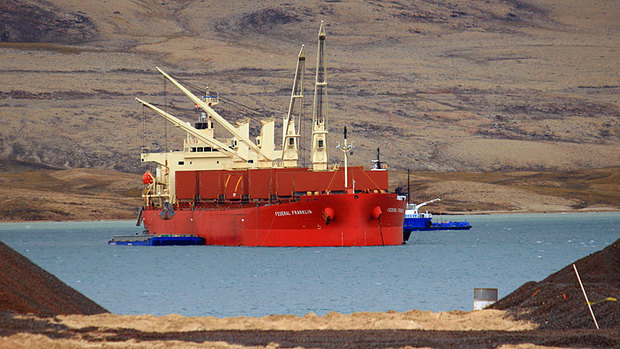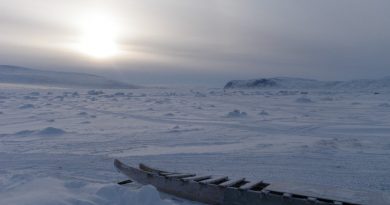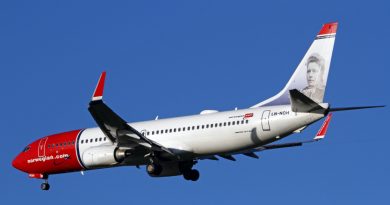How to make Arctic waters safer for ships
 When searchers went looking for Sir John Franklin’s lost vessels this summer, they came up empty as far as shipwrecks from the failed 1845 expedition were concerned.
When searchers went looking for Sir John Franklin’s lost vessels this summer, they came up empty as far as shipwrecks from the failed 1845 expedition were concerned.
But in a bit of Arctic irony, work done during the search in Nunavut will help future mariners navigating through the icy and dangerous waters where HMS Erebus and HMS Terror may have gone down.
Hydrographers who were part of the search gathered enough depth and multi-beam sidescan sonar data to create a preliminary electronic chart that expands the area for safe navigation in Alexandra Strait, reducing travel time and saving fuel costs for vessels in the area.
Andrew Leyzack, the Canadian Hydrographic Service’s hydrographer-in-charge during the Franklin search, says this summer’s result is significant.
Not only will it help reduce travel time for vessels around King William Island by six or seven hours, but it could also provide an alternative navigation route in case of ice in the lower Victoria Strait.
“The time savings and the fuel savings are considerable,” says Leyzack, who noted the new route could also be useful if a vessel runs into trouble.
“In the event of a search-and-rescue call, it just cuts off that much more time if the responding vessels could transit this route as opposed to going all the way around the Royal Geographic Society Islands.”
The new chart — which Leyzack likens to a multi-lane highway replacing a dirt road — will guide ships from Victoria Strait to Storis Passage and comes as the Canadian Hydrographic Service faces increasing demands for mapping and updating navigational charts for the Arctic.
Economic motivation
And just as economic dreams fuelled Franklin’s ultimately doomed quest to find the Northwest Passage, a fiscal motivation lies behind the mounting pressure for better charts. Interests ranging from oil and gas exploration and resource extraction to tourism want to take vessels to new areas and in greater numbers.
Add the impact of changing climate, and retreating ice patterns, along with the desire to do what it takes to avoid shipping accidents and their associated potential environmental threats and salvage costs, and the CHS is under no illusion about the demand for its services.
But don’t expect charts showing every detail of the Arctic seabed north of 60 degrees latitude — an area of about seven million square kilometres — any time soon.
“Canada has the longest coastline in the world and we have three oceans and the Great Lakes,” says Savi Narayanan, the CHS’s director general.
“It is totally unrealistic to have all the areas fully charted to modern standards where any ship can go anytime.”
So the service has been setting priorities.
Ten years ago, the Arctic didn’t rank very high. But that’s changed in the past decade, with the increased Arctic oil and gas exploration, tourism and more traffic in the northern waters.
“We realized we need to have enhanced charting in the Arctic,” says Narayanan.
Staying inside the lines
Tim Keane, vice-president of Enfotec Technical Services, a subsidiary of the Montreal-based bulk shipping company Fednav that specializes in ice analysis and vessel routing, says there are areas within the Northwest Passage where there are scant soundings.
“It could benefit from more extensive soundings to determine exactly how much draft a ship can carry through that area.”
Shippers don’t want to go where they have little guidance about what might lie underneath the water’s surface.
“There are vast areas where there are no surveys or nothing in any chart that would indicate that the area has been well surveyed, so you are restricted in terms of navigating,” says Keane, whose firm works with mining developments that would require bulk shipping in the North, such as Baffinland’s Mary River iron mine.
“Any prudent navigator will never put his ship into a position where he’s outside of a known charted area.”
For the CHS, charting priority is focusing on the main existing navigational channels.
“The area where Parks Canada would like to search for the Franklin ships is also an area of high priority for charting because that is one of the navigational corridors and it’s a really high-risk area because of the weather conditions and the ice conditions,” says Narayanan.
Only about 10 per cent of the total Arctic has been charted and surveyed to a modern standard. Twenty-five to 35 per cent of the main Arctic shipping routes are surveyed and charted to that standard, says Narayanan. (In southern Canada, almost 100 per cent of the most critical channels are charted to that level.)
Changing climate
Retreating Arctic ice has also influenced how the service is determining where to focus its resources.
“Of course climate change is a factor in determining where we need to do charting or where the traffic will go, because we need to make sure that we provide the information … to prevent accidents,” says Narayanan.
In terms of climate change, she says, the ice retreat will happen more on the Russian side of the Arctic, rather than the Canadian, because of the way the water moves in the Arctic Ocean.
During this summer’s Franklin search, hydrographers completed 266 square kilometres of seabed mapping using multi-beam sonar systems on two survey vessels, meeting the CHS’s goal for coverage from those boats.
Another 74 square kilometres of mapping was done from the research vessel Martin Bergmann. That was about half the area expected and largely a result of equipment breakdowns that cost about 80 hours of production time.
An autonomous underwater vehicle provided by the University of Victoria covered about 4.5 square kilometres, not a huge area, but one Leyzack considered a “bonus” because it was the first time the AUV had been deployed during the service’s annual Arctic charting.
This year’s CHS work was part of a three-year plan. Leyzack expects hydrographers will likely be back surveying next summer.
“Each year reveals more clues regarding Canada’s Arctic geography,” he says.
“With the rising number of cargo ships transiting the Northwest Passage, I think it’s rather relevant that we’re here doing this and gathering all the information possible about the environment … not only with a goal to protect the environment, but also to make marine safety our top priority.”
For more northern stories from CBC News, click here


